The Search for the Ideal
Sam Olshin, FAIA
Critical factors for consideration in community placemaking: Philadelphia as a case study
Much has been written about successful communities and why certain places are “destinations” and others are not. Italo Calvino’s “Invisible Cities” emphasizes in poetic prose that the city is a constantly evolving place – simultaneously both being constructed and decaying, aspirational and fleeting. Through this we come to realize: do we ever really know what an ideal space is? On the practical side, one can argue that the critical success factors for “the ideal” community from an architectural perspective are a careful and thoughtful balance of proportion and form, private and public space, active and passive recreational areas, and places for public dialogue and exchange. This leads into the more metaphoric aspects of “ideal” community spaces as places that support dignity, inclusiveness, and fairness – egalitarian ideals.
Many noted writers have addressed the “American experience”- those defining elements that represent what makes spaces and places uniquely American. Those places vary from the New England village, to the urban metropolis, to the open ranch land and the mountainous west. The American authors Wallace Stegner, Wendell Berry, and Willa Cather, among others are particularly insightful in their observations of the impact of the built environment on the natural environment in America. Stegner, a novelist and environmentalist, writes as a cautious observer of the connection of man to the landscape in Angle of Repose and his other work. Similarly, Berry writes longingly in The Unsettling of America for a past where man was more in touch with both the natural and agrarian landscape than he is today. Cather in Death Comes for the Archbishop writes eloquently of Native Americans treating the land historically with reverence and “consideration”, as opposed to the western white settlers who treated the land as a place for unchecked “consumption.” All of these writers address critically our mistreatment of our built and open landscapes and our casual response to the loss of a unique open space or iconic structure. In this same way, cities constantly evolve based on immigration waves, economic factors, climatic conditions, and opportunities available. How these ideas affect the notion of “ideal space” and the impact on our communities of the 21st century is of deep consideration and importance. In the following section, I will discuss Philadelphia, Pennsylvania, USA as a case study critically challenged by these varying factors.
Issues Confronting Greater Philadelphia and Working Towards Progress
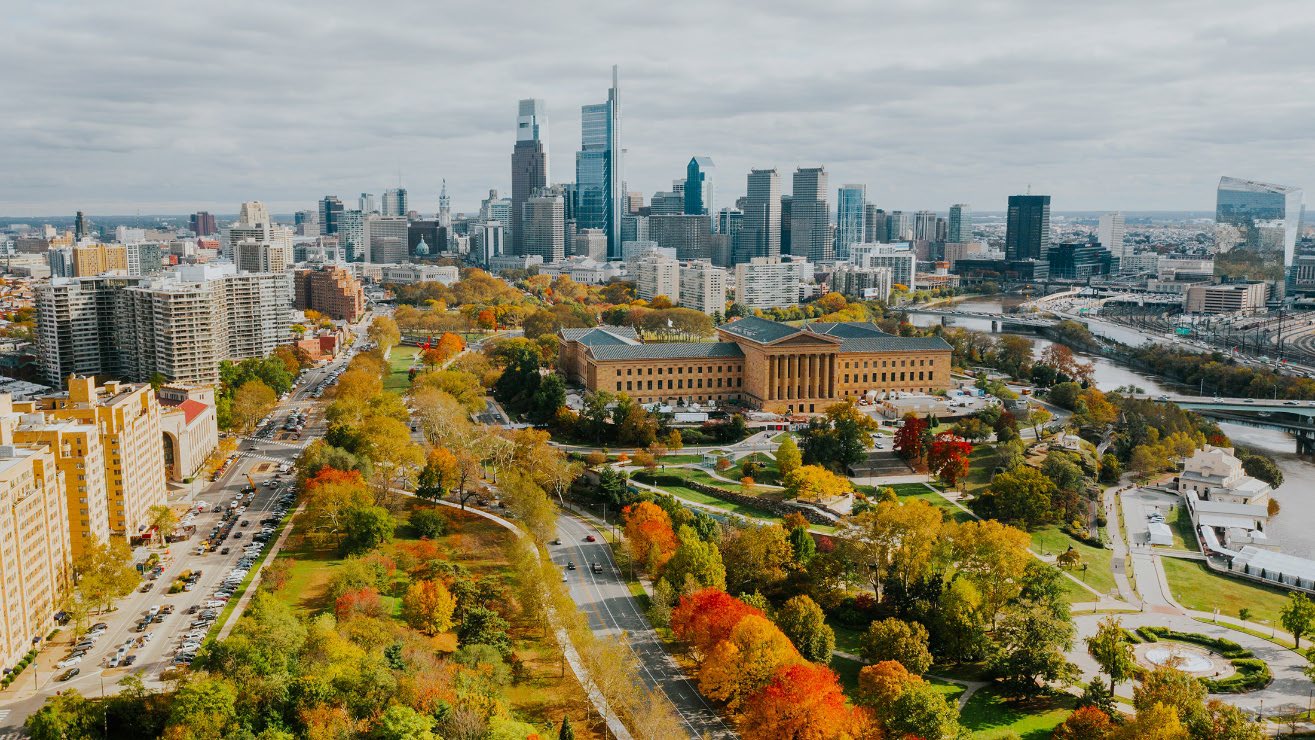
A view of the Benjamin Franklin Parkway- and the Philadelphia Skyline. The Benjamin Franklin Parkway is the city’s most monumental boulevard. The street culminates at entrance to the Philadelphia Museum of Art. Image Source: Visit Philadelphia.
Recently, a primary mayoral election was held in Philadelphia, USA. For the first time, in a field of eight democratic challengers, three women and three African Americans were among the candidates reflecting the city’s demographics better than in any past election of memory. The candidates’ platforms ranged from “progressive” to “tough on crime” to more “moderate.” In November 2023, the winning Democratic mayoral candidate Cherelle Parker, a Black former City Council member, will face off against David Oh, an Asian-American, a Republican, and also a former City Council member. There has not been a Republican mayor of Philadelphia in over 70 years.
The two candidates have a wide-ranging agenda and varied policy initiatives in a city that is racially polarized, suffers from chronic violence and poverty, and has lost over 500,000 people during the last 70 years despite some recent small population gains.1 Philadelphia and the surrounding region boasts internationally recognized arts and cultural institutions, four medical schools, approximately fifteen schools of higher education, and one of the largest urban park networks in the country, but despite that still has serious challenges ahead.
How can we envision the city as a series of multiple “Ideal Spaces” – linked together, egalitarian in nature, accessible to all, and safe and secure? These are the challenges we face and the opportunities ahead:
1. Effects of Covid: It will be some time until we fully understand the effects of the pandemic on our personal health, the health of the community, and the impact on our livelihoods and the global economy in general. What is apparent at this juncture is that we can take nothing for granted, that another future Covid wave is possible, and that “working from home” appears here to stay. We need to envision the city as more residential in nature, with accessible civic spaces and with an emphasis on pedestrian interaction while respecting the importance of public health – and access to it for all.
2. Loss of Regional Open Space and Public Access: America has always been seen as a land of unlimited resources where the consumption of open space is a given. Early 18th-20th century pandemics and disease outbreaks mandated the need for “fresh air” away from the city, but that availability for the masses was not available to all until the invention of the cost-effective automobile by Henry Ford. Easy access to long distance travel led to sprawling development and suburbanization. The result has been the ongoing depletion of woodlands and farmland for housing developments, office parks, and e-commerce warehouses all while chasing “The American Dream”. In the wake of this development, the city can be left with a dearth of parks and open space. We need to envision the city as a series of neighborhoods, as important as is “the downtown”, with an emphasis on pedestrian interaction and shared resources and amenities.
3. Deteriorating Infrastructure: In a city that is almost 350 years old and that expanded rapidly after WWII, the job to repair and replace aging underground pipes and various distribution systems is endless. However, infrastructure is what makes a modern city run – including hi-speed internet which needs to be free and accessible to all. We need to envision the city as a series of intrinsically linked squares and spaces, adequately served by well-maintained infrastructure – and in turn providing neighborhoods with destination and event spaces for passive and active recreation.
4. Growing Wealth Gap: Since the end of WWII when rapid suburbanization began, and “White flight” escalated, and the “Workshop of the World” that was Philadelphia began to wind down (sending well-paying manufacturing jobs elsewhere), the city has never fully recovered from these tumultuous events.2 We need to address the substantial differences between core, stable, and well-maintained neighborhoods like Society Hill and Chestnut Hill – and those in North Philadelphia and Southwest and elsewhere that lack affordable housing, safe play areas, jobs, and job training. We cannot have an egalitarian society when we have neighborhoods that are food deserts, lack basic amenities, and are devoid of access to open space, and arts and culture for all.
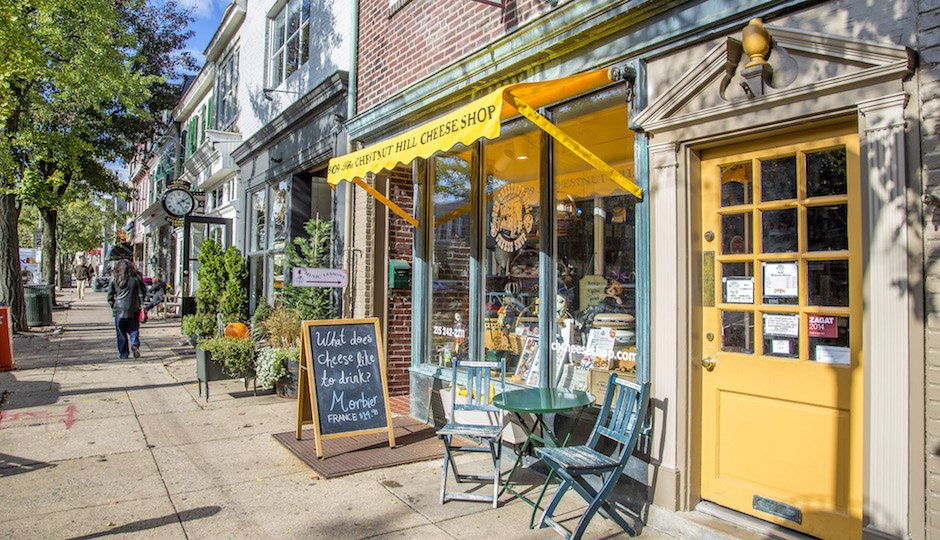
A local business in Philadelphia’s Chestnut Hill neighborhood. The affluent neighborhood is loved for its main street consisting of small shops and locally-owned restaurants. Image Source: Philadelphia Magazine, Panel to Tackle, Past, Present and Future in Chestnut Hill, 2017.
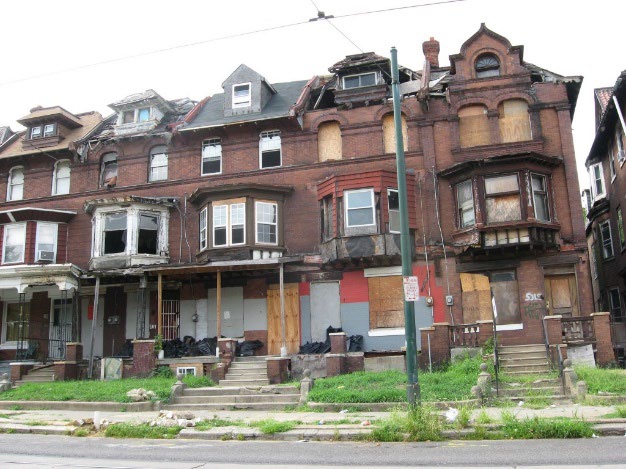
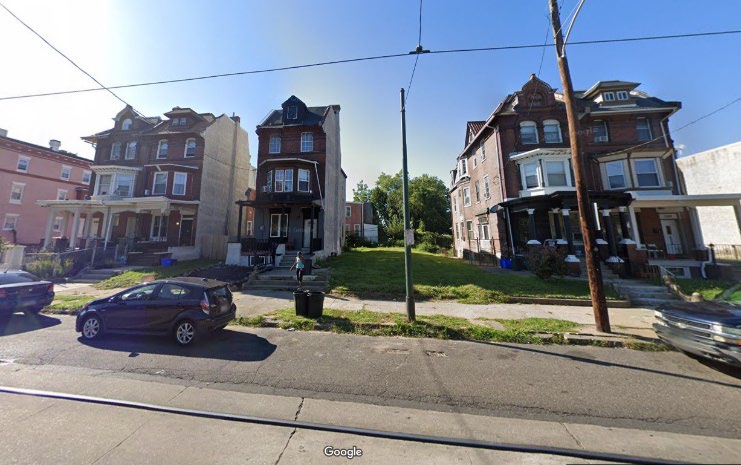
Residences in Southwest Philadelphia, in the 5300 block of Chester Ave. The neighborhood has historically struggled with problems of maintenance and lack of resources. Left: Vacant Houses in 2012, Image sourced from neighborhood blog, The Sanguine Root. Right: The same houses in 2019. Some residences have been occupied, while others have been demolished. Image Source: Google Earth, Accessed 2023.
5. Lack of Appropriate Job and Career Opportunities: For the most part, those that are well educated and that have access to community support and resources are well suited to pursue the myriad of service sector jobs that exist in the city especially in the healthcare and bio-tech sector. However, the loss of well-paying manufacturing jobs has hurt the city, and job opportunities for those with a limited education are stifling. This phenomenon has exacerbated an already widening economic divide. We need to continue to promote the city as are source for employers and institutions looking to hire the highly skilled and well-educated. We also need to make sure that those that have been marginalized are better served through vocational training, mentoring, access to job recruiting, public transportation ,and start-up capital.
6.Loss of Civility: Thecity has traditionallybeen a place whereconstantinteraction andengagementhas defined the urban experience be it onthefactoryfloor, neighborhoodtaproom,or in the school yard. Resolution todisagreementwas never easy,but it typically involved a face-to-face exchange. Today’s world ismuch more global and exchanges are most often handledthrough text messages,social media, or similar moreremoteexchange. As a result, we have lostan appreciation ofshared destiniesand civic pride. We need tostress theimportanceof deference,patience,generosity,philanthropy,civic commitment,personal responsibility,and theall-importantneed formentorsand role models.
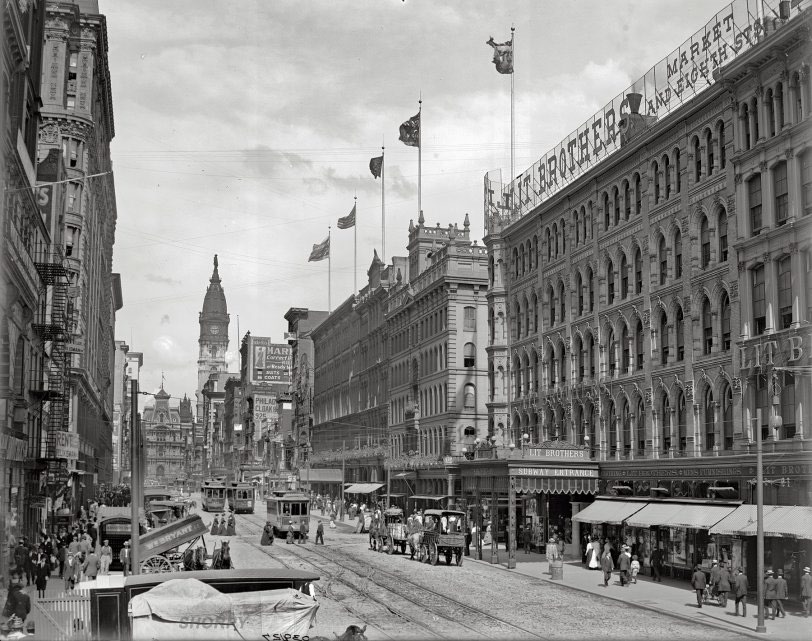
Market Street, 1905. Philadelphia’s Market Street is a notable historic commercial corridor. Image Source: Shorpy: American Historical Photo Archive.
7. The Changing Retail Climate: The city has always been defined by a downtown with a central “Main Street”, the place to see and be seen, and the place to do banking, secure provisions, and partake in community activities. The importance of a central business district as an economic generator, as a destination, and as a definer of place cannot be underestimated. The highway by-pass served as the first crushing blow to Main Street, followed by Big Box retail, then e-commerce, and then Covid. One only needs to walk through our downtowns today to see a multitude of graffiti-marked empty storefronts. We need to re-consider and re-invent the storefront as a destination – in all neighborhoods, and not just downtown. Small scale neighborhood retail opportunities (that may include baking classes, home repair training, etc.) better defines a “sense of place”. At the small mom-and-pop storefront level, these small-scale start-ups are what generates economic opportunities, job opportunities for youth, community destinations, and overall neighborhood revitalization.
8. The Public School System: The public school system in America is almost 200 years old and was founded based on a government commitment to investiture in public education believing that it would benefit the whole nation by transforming “children into literate, productive, and moral citizens.”3 However, the disparity in school district funding between suburban and urban districts based on real estate tax revenue is both morally unfair and is shortchanging us as a society and culture. We need to focus on providing amenities and services to keep young, dedicated, and committed families in the city – of all backgrounds. This means providing safe well-funded schools where people want to teach – and where people want to send their children – be it with college in mind long term or for future vocational training.
9. Climate Change and Sustainability: Cities face unprecedented threats from long hot summers, increased severity of storms, unpredictable weather patterns, and rising ocean levels. We must address the importance of these issues and its impact on the city and the essential efforts of planting more street trees especially in the underserved neighborhoods. These efforts need to extend into supporting more recycling efforts, expanding the use fossil fuel alternatives such as solar panels, and promoting more holistic sustainable design strategies and energy efficiencies. Further, the city is not a place where everyone is going to have electric car charging stations anytime soon; many will never even own a car by choice or otherwise. As a result, there needs to be a long-term government support and investment in public transportation that is accessible, low cost, and safe.
10. A Response to Gun Violence: In a country where its Founding Fathers promised its citizens the “right to bear arms”, many of its citizens have heard the call and are well-armed. The national debate of what the Founding Fathers really meant and whether we as citizens are within our constitutional right to own automatic weapons or “ghost guns” will continue for years to come. The proliferation of guns in the city, the seeming inability to resolve heated disputes without weapons, and the futility and desperation and sense of loss that is evident is a tragic impediment to a city’s health and well-being.
Pervasive gun violence is nothing more than a sign of systemic failure on a civic scale. We cannot as a civil society succeed in this endeavor without shared economic opportunities, access to affordable housing and education, and open space accessible to all.
Sam Olshin, FAIA
M. Arch, University of Pennsylvania
Principal, Atkin Olshin Schade Architects
Senior Lecturer, Bryn Mawr College
References:
Berry, Wendell. 1977. The Unsettling of America: Culture & Agriculture. Berkely: Counterpoint Press.
Cather, Willa. 1990 [1927]. Death Comes For The Archbishop. New York: Vintage Books.
Kober, Nancy Et. Al. 2020. History and Evolution of Public Education in the US. Washington, DC:
Center on Education Policy, the George Washington University.
The Oliver Evans Chapter of the Society for Industrial Archeology. 1990. Workshop of the World: A Selective Guide to the Industrial Archeology of Philadelphia. Wallingford: The Oliver Evans Press.
Hajer, Maarten Et. Al. 2020. Neighborhoods for the Future: A Plea for Social and Ecological Urbanism. Amsterdam: Pia Pol, Simon Franke & Astrid Vostermans.
Stegner, Wallace. 1992. Where the Bluebird Sings to the Lemonade Springs: Living & Writing in the West. New York: Penguin Books.
1 Population data from World Population Review. https://worldpopulationreview.com/us-cities/philadelphia-pa-population
2 Philadelphia as the “Workshop of the World” comes from the anthology published by Oliver Evans Press, 1990. The title references Philadelphia’s long and influential history of industrial production and manufacturing infrastructure.
3 Nancy Kober. History and Evolution of Public Education in the US (Washington DC: Center on Education Policy, GWU, 2020), 3.
